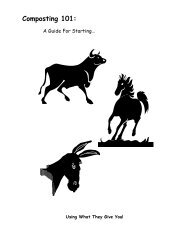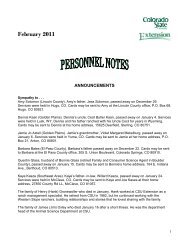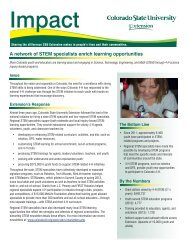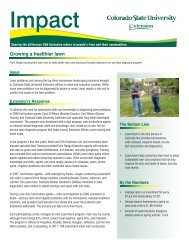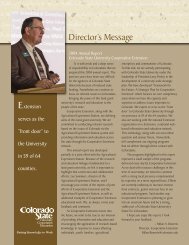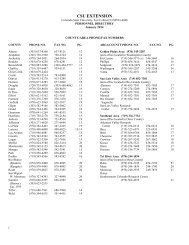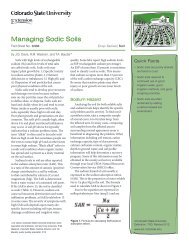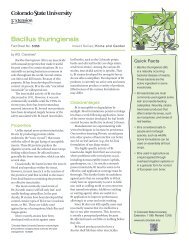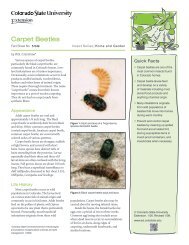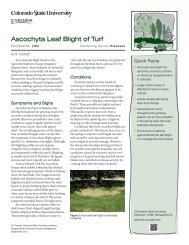Poster Design Tips and Techniques - Colorado State University ...
Poster Design Tips and Techniques - Colorado State University ...
Poster Design Tips and Techniques - Colorado State University ...
Create successful ePaper yourself
Turn your PDF publications into a flip-book with our unique Google optimized e-Paper software.
Putting It All Together:<br />
Modular <strong>Poster</strong><br />
After designing your poster <strong>and</strong><br />
gathering the materials, it’s time to<br />
assemble it:<br />
• Cut out your display pieces, <strong>and</strong><br />
trim your photos <strong>and</strong> charts.<br />
Use a long, clear ruler with a lipped<br />
edge when cutting so that you can<br />
see your work as you go. Make<br />
straight cuts: dull blades or scissors<br />
leave ragged edges. Always use a<br />
sharp blade <strong>and</strong> work when you are<br />
alert to ensure straight, even edges.<br />
• Place all display elements in order.<br />
Use a board or a taped section on<br />
the floor or wall <strong>and</strong> step back to see<br />
how it looks. Take the time before<br />
you leave for the event to replace<br />
what doesn’t look right. If it doesn’t<br />
look right to you it definitely won’t<br />
look right to your audience. Have a<br />
peer critique it.<br />
• Write down your sequence of<br />
display elements or photograph<br />
your poster layout.<br />
Put it in a folder with your poster<br />
components (text, images <strong>and</strong><br />
background papers, pins <strong>and</strong> other<br />
fasteners) so you’ll remember how<br />
you want it to look when you start<br />
to construct the poster on site. A<br />
Polaroid or digital camera works<br />
well for this.<br />
• When transporting display items<br />
that have Velcro backing:<br />
be sure to pack them face to face<br />
so the Velcro does not scratch the<br />
printed panels.<br />
• When you construct the poster on<br />
site:<br />
Take a minute to step back <strong>and</strong> view<br />
the poster. Straighten any crooked<br />
pieces <strong>and</strong> remove anything that<br />
is distracting before your audience<br />
arrives.<br />
Putting It All Together:<br />
Large Format Printout <strong>Poster</strong><br />
• Print out a hard copy of your final<br />
poster version.<br />
Submit both the hard copy <strong>and</strong> a<br />
disk to the printer.<br />
• Make sure the word processing or<br />
graphics program you’re using is<br />
compatible with the commercial<br />
printer’s software.<br />
Use an acceptable font; certain<br />
fonts downloaded from the<br />
Internet may not work.<br />
THE DON’T LIST<br />
Resources–Web <strong>and</strong> Print<br />
• Choose the poster material best<br />
suited to your needs <strong>and</strong> budget.<br />
Large format posters can be<br />
produced on paper, with or<br />
without lamination, or printed on<br />
vinyl.<br />
• Allow enough lead time<br />
Most printers need at least 24-48<br />
hours.<br />
• Protect your poster<br />
Transport it rolled up in a tube.<br />
A good poster doesn’t need to be expensive but it does need to<br />
have a good design <strong>and</strong> an interesting message. Here’s what you<br />
should NEVER do:<br />
Don’t:<br />
• Use your actual research paper as the poster.<br />
• Use a text font smaller than 24 points.<br />
• Clutter the board with too much text or too many images.<br />
• Use too many different colors or patterns.<br />
• Use lots of jargon or boring language.<br />
• Make sloppy cuts on your panels.<br />
• Use light letters on a dark background.<br />
• Leave out the title, your institution, <strong>and</strong> your name.<br />
• Forget to proofread your poster.<br />
Some good sources on the Internet for creating posters include the following:<br />
• www.siam.org/meetings/guidelines/poster.php<br />
• www.writing.engr.psu.edu/posters.html<br />
Many professional societies have published guidelines on poster design.<br />
Here is example:<br />
The ACS Style Guide: A Manual for Authors <strong>and</strong> Editors, 2nd edition<br />
Janet S. Dodd, editor<br />
The American Chemical Society<br />
ISBN 0841234620<br />
For information on fonts <strong>and</strong> design:<br />
The Non-<strong>Design</strong>er’s <strong>Design</strong> Book, Robin Williams<br />
Peachpit Press, Berkeley, CA<br />
ISBN 1566091594



